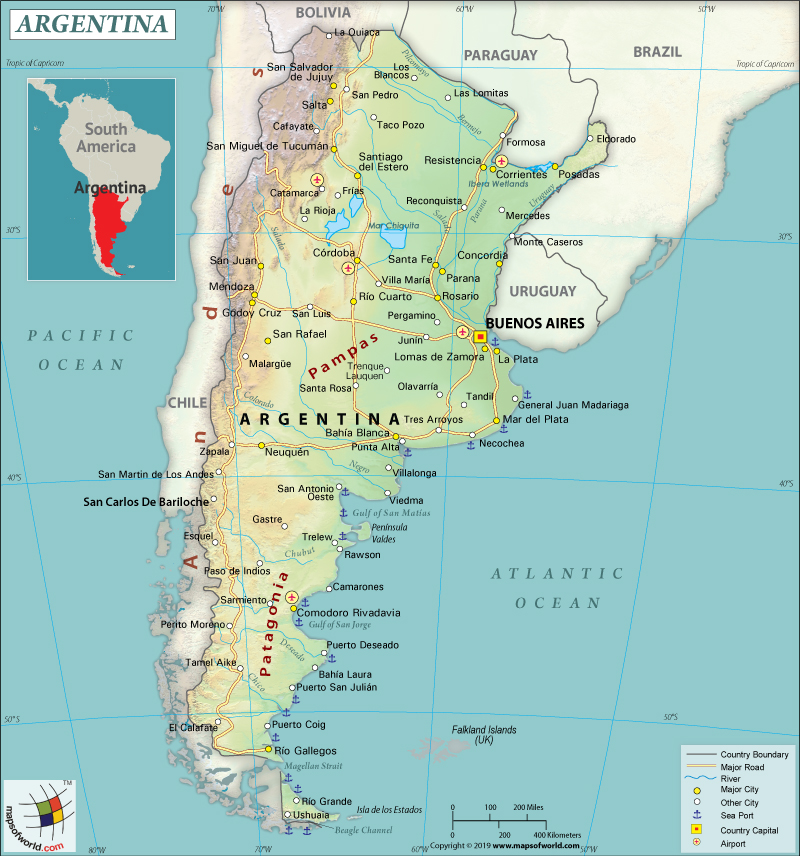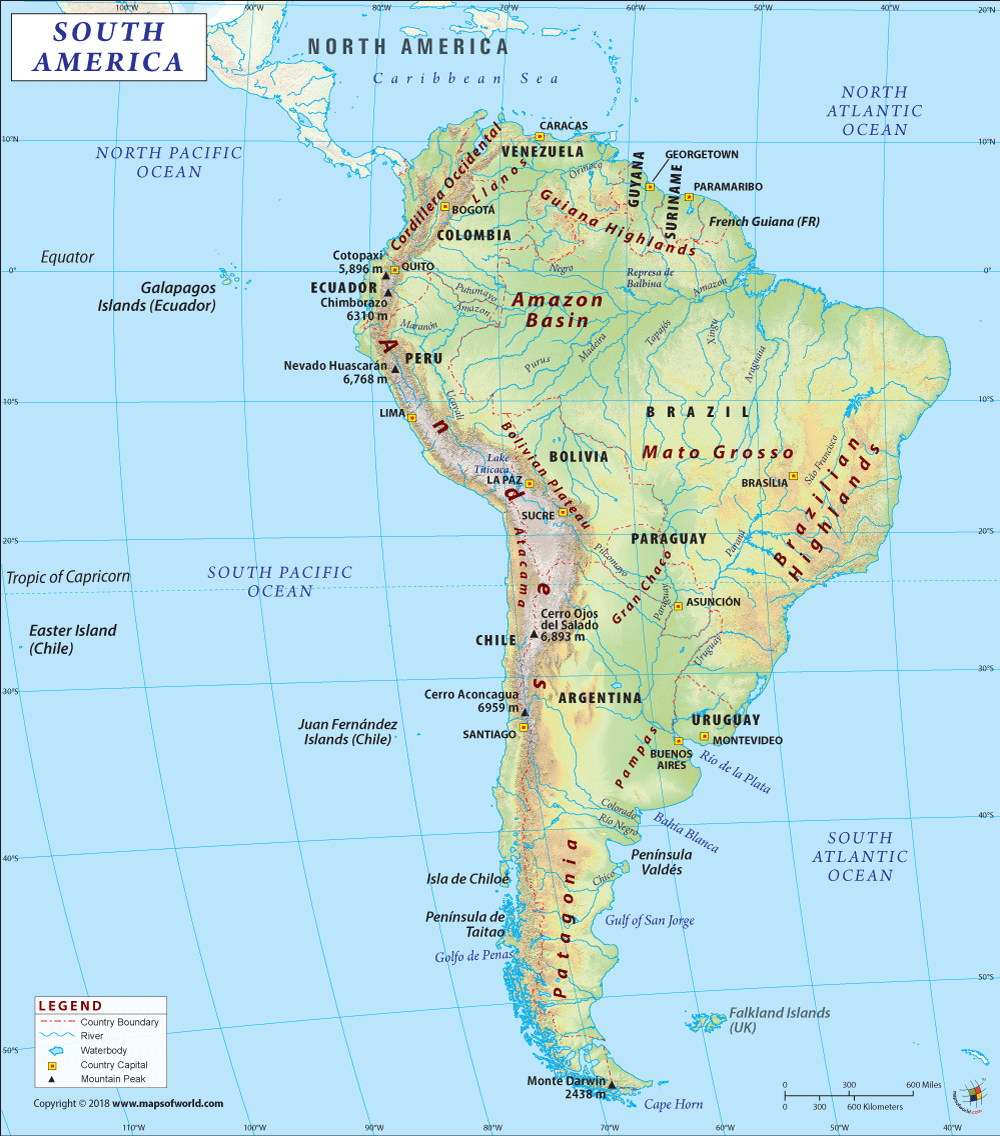What are the Key Facts of Argentina?

|
Official Name |
Argentine Republic |
|
Continent |
South America |
|
Capital |
Buenos Aires |
|
Largest City |
Buenos Aires |
|
Coordinates |
-34.000000, -64.000000 |
|
Area |
1,073,500 sq mi ( 2,780,400 sq km) |
|
Land Boundaries |
5,826 mi ( 9,376 km) |
|
Coastline |
3,100 mi ( 4,989 km) |
|
Currency |
Peso ($) (ARS) |
|
Neighboring Countries |
Chile, Paraguay, Brazil, Bolivia, Uruguay |
|
Population |
43,847,430 (2016 est. ) |
|
Official Languages |
Spanish |
|
Major Religion |
Christianity |
|
National Day |
9 July (Independence Day) |
|
National Anthem |
“Himno Nacional Argentino” |
|
Form of Government |
Federal presidential constitutional republic |
|
President |
Alberto Fernandez |
|
Vice President |
Cristina Fernandez de Kirchner |
|
GDP per capita (PPP) |
$ 20,567.3 (World Bank, 2018) |
|
GDP per capita (nominal) |
$ 11,652.6 (World Bank, 2018) |
|
HDI |
0.825 (2017), Rank: 47 |
|
Literacy Rate (%) |
99.13 (UNESCO, 2016) |
|
Space Agency |
NA |
|
Military Expenditure Ranking |
36 (SIPRI, 2017) |
|
No. of Olympic Medals |
74 (as of 2018) |
|
Driving Side |
right |
|
Calling Code |
+54 |
|
Time Zone |
UTC−3 (ART) |
|
Internet TLD |
.ar |
Where is Argentina?
Argentina is officially known as the Argentine Republica. It is a vast country located in the southern part of South America. Argentina is the eighth largest country in the world and the second largest in Latin America after Brazil. Total area of Argentina is 2,736,690 square kilometers (1056641.92 square miles) of land and 43,710 square kilometers (16876.525 square miles) of water. Argentina became independent from Spain in 1816.
Argentina is bordered by Chile to the south and west, Bolivia and Paraguay to the north and Brazil, Uruguay, and the Atlantic Ocean to the east.
What is the Geography of Argentina?
Argentina can be divided into four regions: the Andes, the North, the Pampas and Patagonia. The Pampas is the centrally located plains. It is the agricultural heartland of the country.
Argentina is full of natural resources. Many large rivers are flowing in Argentina. Some of the important rivers are Parana river which is the second largest river after the Amazon in South America. The Uruguay River, Negro River, Bermejo River are the other big rivers, among others.
The Los Lagos Region (Lake District) is located on the border of Chile. Andes mountain regions are replete with many glacial lakes. But the largest lake of Argentina is Logo Buenos Aires. Lake Mar Chiquita (Little Sea) is a famous saltwater lake. Rio Negro is a different type of lake. It is considered one of the largest manmade lakes of Argentina.
The climate of Argentina varies from the north to the south. Being located in the Southern Hemisphere, the Argentine winter coincides with the summer in North America, and vice versa. In the northern areas, the weather remains very hot and humid throughout the year, with plenty of rainfall, though it is a bit mild and dry in winters. The central part of the country, including the Argentinian capital Buenos Aires, has a temperate climate. The mountain regions of Andes and Patagonia remain cool and dry in summers and become very cold in winters. The southern parts experience sub-polar climate, with fairly cold summers and sudden storms made up of rain or snow, or a mix of the two.
What is the Economy of Argentina?
Argentina’s economy is considered the second largest economy of South America after Brazil. This South American country is full of fertile land and natural resources for renewable energy. If we look towards the history of Argentina’s economy, then we find that its growth has been very uneven. Despite the high economic growth in Argentina, its consistency is never maintained, and growth periods have alternated with severe recessions. This has led to disparity in income and increase in poverty. This has been sought to be corrected through structural reforms and social inclusion in the last few years.
Argentina’s GDP declined 2.5% to US$518.48 billion, from US$642.70 billion in 2018. Its unemployment rate was estimated at 8.347% in 2017 (World Bank). Still, the literacy rate of Argentina is very high. It is more than 97%, and the country enjoys a high Human Development Index.
In the early twentieth century, Argentina’s economy was very sound. The military dictatorship from 1976 to 1983 was very much responsible for the downfall of Argentina’s economy. Martinez de Hoz, the chief economist during the period of dictatorship, implemented a corrupt anti-labor policy of financial liberalization that was responsible for the increase in debt burden and became a hurdle in the industrial development. A large number of companies of all sizes went bankrupt by 1982 and the neoliberal economic policy from 1983 to 2001 failed to make any impact.
Since 2003, expansionary policies and commodity exports helped to improve Argentina’s economy. The GDP has been growing. Job opportunities have increased, and unemployment rate went down drastically. Several important firms were privatized. These changes led to an improvement in the economy of this South American country and lent it a certain momentum. Yet, it has been dogged by high inflation, and its currency declined by about 50.6% in 2018.
Agriculture is the backbone of Argentina. It creates job opportunities as well as improves the overall economic conditions. Argentina is a major exporting nation of beef, citrus fruits, grapes, honey, sunflower seeds and many more. Fisheries in Argentina are also very advanced.
Argentina is famous for exporting soybean meal, corn, delivery trucks, cars and many more. Meanwhile Argentina imports various goods like computers, machinery goods, and especially electrical machinery. Argentina’s leading trading partners are Brazil, USA, China, Chile, Germany and others.
Córdoba is Argentina’s industrial hub. The main industry of Argentina is established near its capital Buenos Aires. Since 2002, textile, automobile tyres and oils are the best performing industries in Argentina.
What is the Transportation System of Argentina?
Transport in Argentina is normally inexpensive. Long-distance buses are available on nominal charges. The country has many national and international airports. In the urban areas, bus is the main source of transportation.
Taxi is very common and available at economical rates. Metro rail is also available for the public. But metro is available in limited cities only. Trams are also a good source of transportation for the commuters. High speed trains and long-distance buses are also available for going from one place to another. As far as transportation in Argentina is concerned, it is very advanced and less expensive.
Argentina has 6 registered air carriers, and 1138 airports. Its railway network is 36,917 km (22,939 miles) long, roadways are 280,290 km (174,164 miles), and waterways cover 11,000 km (6,835 miles).
What Organizations is Argentina Part of?
AfDB (nonregional member), Australia Group, BCIE, BIS, CAN (associate), CD, CELAC, FAO, FATF, G-15, G-20, G-24, G-77, IADB, IAEA, IBRD, ICAO, ICC (national committees), ICCt, ICRM, IDA, IFAD, IFC, IFRCS, IHO, ILO, IMF, IMO, IMSO, Interpol, IOC, IOM, IPU, ISO, ITSO, ITU, ITUC (NGOs), LAES, LAIA, Mercosur, MIGA, MINURSO, MINUSTAH, NAM (observer), NSG, OAS, OPANAL, OPCW, Paris Club (associate), PCA, SICA (observer), UN, UNASUR, UNCTAD, UNESCO, UNFICYP, UNHCR, UNIDO, Union Latina (observer), UNTSO, UNWTO, UPU, WCO, WFTU (NGOs), WHO, WIPO, WMO, WTO, ZC
Related Links:


